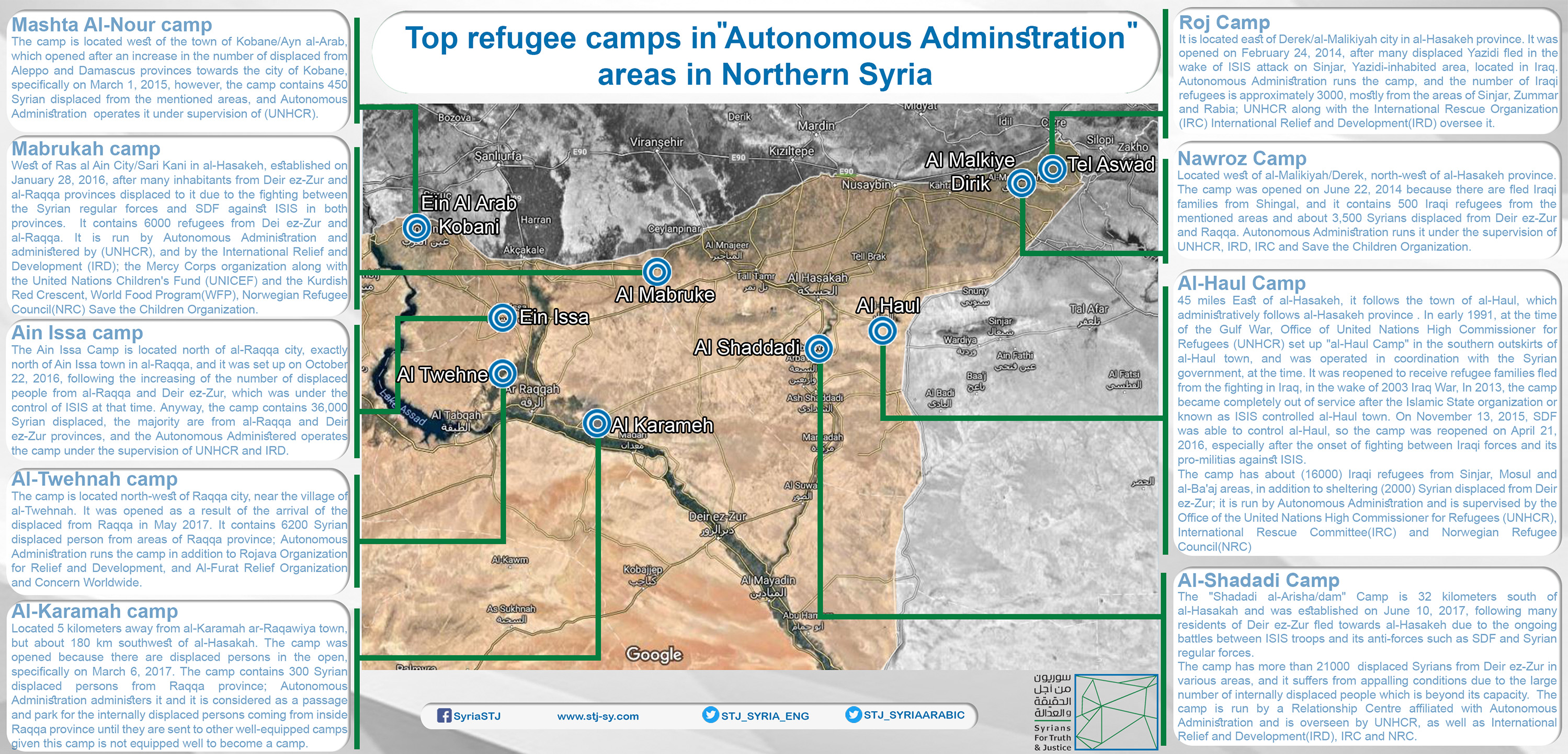This sheet provides background information on the camps in the Syrian Democratic Forces/SDF-controlled areas, as we publish this paper parallel with a special report on Ain Issa Camp and the most significant challenges that face the camp residents as well as their most important needs with the arrival of winter.
First: The al-Haul Camp
Al-Haul Camp, east of al-Hasakeh city, is 45 miles away, and the camp actually follows the town of al-Haul, which administratively follows al-Hasakeh province . In early 1991, at the time of the Gulf War, Office of United Nations High Commissioner for Refugees (UNHCR) set up "al-Haul Camp" in the southern outskirts of al-Haul town, and was operated in coordination with the Syrian government, at the time. It was reopened to receive refugee families fled from the fighting in Iraq, in the wake of 2003 Iraq War.
In 2013, the camp became completely out of service after the Islamic State organization or known as ISIS controlled al-Haul town. On November 13, 2015, SDF was able to control al-Haul, so the camp was reopened on April 21, 2016, especially after the onset of fighting between Iraqi forces and its pro-militias against ISIS.
The camp currently has about (16000) Iraqi refugees from Sinjar, Mosul and al-Ba'aj areas, in addition to sheltering (2000) Syrian displaced from Deir ez-Zur; the camp is run by Autonomous Administration and is supervised by the Office of the United Nations High Commissioner for Refugees (UNHCR), International Rescue Committee(IRC) and Norwegian Refugee Council(NRC).
Second: Roj Camp
Roj Camp is located east of Derek/al-Malikiyah city in al-Hasakeh province. However, it was opened on February 24, 2014, after many displaced Yazidi fled in the wake of ISIS attack on Sinjar, Yazidi-inhabited area, located in Iraq. Autonomous Administration runs the camp, and the number of Iraqi refugees is approximately 3000, mostly from the areas of Sinjar, Zummar and Rabia; UNHCR along with the International Rescue Organization (IRC) International Relief and Development(IRD) oversee it.
Third: Mabrukah Camp
The "Mabrukah Camp", west of Ras al Ain City/Sari Kani in al-Hasakeh, it was established on January 28, 2016, after many inhabitants from Deir ez-Zur and al-Raqqa provinces displaced to it due to the fighting between the Syrian regular forces and SDF against ISIS in both provinces. It contains 6000 refugees from Dei ez-Zur and al-Raqqa. It is run by Autonomous Administration and administered by (UNHCR), and by the International Relief and Development (IRD); the Mercy Corps organization along with the United Nations Children's Fund (UNICEF) and the Kurdish Red Crescent, World Food Program(WFP), Norwegian Refugee Council(NRC) Save the Children Organization work in the camp.
Fourth: al-Shadadi Camp
The "Shadadi al-Arisha/dam" Camp is 32 kilometers south of al-Hasakah and was established on June 10, 2017, following many residents of Deir ez-Zur fled towards al-Hasakeh due to the ongoing battles between ISIS troops and its anti-forces such as SDF and Syrian regular forces.
The camp has more than 21000 displaced Syrians from Deir ez-Zur in various areas, and it suffers from appalling conditions due to the large number of internally displaced people which is beyond its capacity. The camp is run by a Relationship Centre affiliated with Autonomous Administration and is overseen by UNHCR, as well as International Relief and Development(IRD), IRC and NRC.
Fifth: Ain Issa Camp
The Ain Issa Camp is located north of al-Raqqa city, exactly north of Ain Issa town in al-Raqqa, and it was set up on October 22, 2016, following the increasing of the number of displaced people from al-Raqqa and Deir ez-Zur, which was under the control of ISIS at that time. Anyway, the camp contains 36,000 Syrian displaced, the majority are from al-Raqqa and Deir ez-Zur provinces, and the Autonomous Administered operates the camp under the supervision of UNHCR and IRD.
Sixth: Mashta al-Nour Camp
The camp is located west of the town of Kobane/Ayn al-Arab, which opened after an increase in the number of displaced from Aleppo and Damascus provinces towards the city of Kobane, specifically on March 1, 2015, however, the camp contains 450 Syrian displaced from the mentioned areas, and Autonomous Administration operates it under supervision of (UNHCR).
Seventh: Nawroz Camp
The camp is located west of al-Malikiyah/Derek, north-west of al-Hasakeh province. The camp was opened on June 22, 2014 because there are fled Iraqi families from Shingal, and it contains 500 Iraqi refugees from the mentioned areas and about 3,500 Syrians displaced from Deir ez-Zur and Raqqa. Autonomous Administration runs it under the supervision of UNHCR, IRD, IRC and Save the Children Organization.
Eighth: al-Twehneh Camp
The camp is located north-west of Raqqa city, near the village of al-Twehnah. It was opened as a result of the arrival of the displaced from Raqqa in May 2017. It contains 6200 Syrian displaced person from areas of Raqqa province; Autonomous Administration runs the camp in addition to Rojava Organization for Relief and Development, and Al-Furat Relief Organization and Concern Worldwide.
Ninth: al-Karamah Camp
The camp is located 5 kilometers away from al-Karamah ar-Raqawiya town, but about 180 km southwest of al-Hasakah. The camp was opened because there are displaced persons in the open, specifically on March 6, 2017. The camp contains 300 Syrian displaced persons from Raqqa province; Autonomous Administration administers it and it is considered as a passage and park for the internally displaced persons coming from inside Raqqa province until they are sent to other well-equipped camps given this camp is not equipped well to become a camp.


